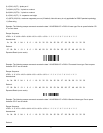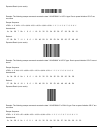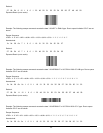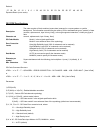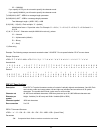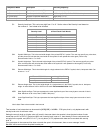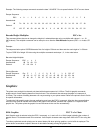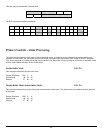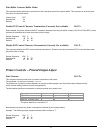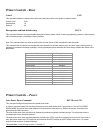
24
Example: The following escape commands encode the data “12345678”. Due to space limitation CR LF are not shown
Escape Sequence:
ESC z 9 1 2 0 0 2 6 0 8 1 2 3 4 5 6 7 8
Hexadecimal :
1B 7A 39 31 32 30 30 32 06 00 08 31 32 33 34 35 36 37 38
Decimal:
27 122 57 49 50 48 48 50 6 0 8 49 50 51 52 53 54 55 56
Barcode Height Multiplier ESC z h n
This command allows the user to change the height of a selected barcode using a multiplier with values 1 < n < 18
(HEX values). The multiplier command can be sent prior to or after the Print Barcode sequence (ESC z t n h data CR
LF)
Example:
The sequence below prints CODE39 barcode first of a height of 50 dots and then sets the new height to 3 x 50 dots.
To print CODE-39 of height 150 dots using the multiplier command send steps 1, 2, in the order below.
Barcode Height Multiplier
Escape Sequence: ESC z h 3
Hexadecimal: 1B 7A 68 03
Decimal: 27 122 104 3
Printing Barcode:
Escape Sequence: Esc Z 1 7 2 C O D E - 3 9 CR LF
Hexadecimal: 1B 5A 31 07 32 43 4F 44 45 2D 33 39 0D 0A
Decimal: 27 90 49 7 50 67 79 68 69 45 51 57 13 10
Graphics
The printer uses a single line thermal print head with elements spaced at 0.125mm. The 8-bit graphic commands
enable control of each heating element of the print head. The commands also advance the paper in increments of
0.125mm. The number of heating elements can vary according to your printer model. Refer to the printer’s User’s Guide
for specific information.
To select the 8-bit graphic mode, the user application must issue the ESC V command. After that, the user application
must send two bytes to indicate the number of the graphic lines desired, followed with a packet of 72 bytes for each
graphic line. The printer prints the graphic line and advances to the next line automatically.
8-Bit Graphics ESC V n1 n2 data
8-bit Graphic mode is selected using the ESC V command. <n1> and <n2> is a 16 bit integer indicating the number of
graphic lines of 72 characters each to be received. Valid Graphic character sets range from 0x00 to 0xFF Hex using bits
0-7
To achieve optimized smooth printing and to extend battery life when printing graphics, a print buffer is employed. The
printer buffer accumulates a specific amount of data before actually printing the graphic data.




